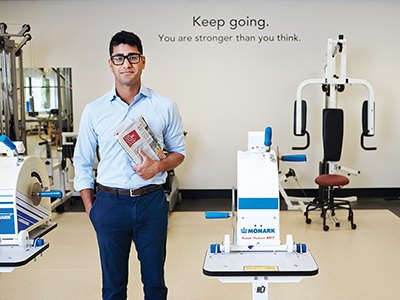Raising Their Voices
Residents Drs. Adam Kassam and Jane Thornton are taking their roles as health advocates seriously – using their voices to effect meaningful change in Canadian health care
By Crystal Mackay, MA’05
“Of those to whom much is given, much is expected.” Dr. Jane Thornton, BSc’00, MSc’02, PhD’07, cites this well-known quote when examining the motivation behind her advocacy.
“No one sees the ways health care can improve more than those of us who are caring for patients on a daily basis. That in itself makes us powerful advocates for health.”
The Royal College of Physicians and Surgeons of Canada highlights ‘health advocate’ as one of the core competencies that physicians require to effectively meet the health care needs of the people they serve. The College poignantly asserts that ‘advocacy requires action’ and that improving health is not limited to mitigating illness or trauma, but also involves health promotion and health protection.
Drs. Thornton and Adam Kassam, residents at Schulich Medicine & Dentistry, have embraced this doctrine, and have each become vocal advocates for change. While they may be approaching the major medical issues of our time from different angles, they share a common goal: to raise their voices to improve the health of Canadians.
Movement as Medicine
Dr. Thornton’s mission is a straightforward one: to promote the notion that physical activity is an effective component of prevention and treatment for many chronic diseases and find ways to translate that to patients. The road to get there has been less straightforward but is one that Dr. Thornton has been committed to pursuing for the past decade.
It all started when she joined a ‘learn to row’ program with her friends at the beginning of high school. She went from being a sedentary teenager who played video games and ate junk food to being an athlete in a matter of months.
“I saw the effect that physical activity had on me personally – beyond the physical health benefits, it helped me understand teamwork, commitment and perseverance,” she said. That experience instilled a passion for athletics. She pursued an education in kinesiology and eventually had the opportunity to represent Canada in rowing in the 2008 Olympics in Beijing, China.
After completing a PhD in exercise and sport medicine and researching inflammatory diseases like asthma, she really focused in on the power of physical activity for the treatment of chronic disease. When she began her medical training at the University of Toronto, she was surprised to find that at that time physical activity wasn’t discussed as a treatment option in lectures or clinical rotations. This appeared to be the case in other medical schools as well.
“I think that was the trigger for me,” she said. “I felt the wealth of evidence necessitated a response and greater representation in our medical education.”
One of her biggest early successes was convincing the curriculum director at the University of Toronto to include physical activity education in the medical curriculum. That was the catalyst to get the ball rolling on a national level, and she is now leading a national strategy for medical schools across the country, encouraged by the Canadian Medical Association passing a motion that she put forward to prioritize physical activity in medical school curricula.
Experiencing those early successes solidified for her that speaking out could actually lead to meaningful change. “It was a big deal at the time because it validated a lot of hard work that had gone into this initiative. It was a necessary link in the chain to get other things underway.”
Now as a resident in Family Medicine, her research and advocacy currently focus around how to talk to patients about physical activity and ways for physicians to take this knowledge and implement it effectively into their practices for chronic disease treatment and prevention.
She most recently founded My Active Ingredient, which includes a hub and social media presence aimed at helping practitioners and health care providers promote the idea of ‘movement as medicine’ and she has written several blog posts and op-eds on the topic.
“Talking to our patients about weight loss or exercise has turned out to be a hard nut to crack. We are talking about a behaviour change that for a lot of people seems really hard to do.”
She has recently created a series of evidence- based patient handouts advocating for physical activity for common chronic conditions that present in family practice – from mental health to type 2 diabetes.
“Years of training at an elite level definitely builds a sense of discipline, commitment and toughness. Realizing my dream of competing at the Olympics fuelled my perseverance and belief that I could transfer those qualities to a career in medicine.” —Dr. Jane Thornton, BSc’00, MSc’02, PhD’07
When asked how her experience as an athlete at the Olympic level has influenced her as a physician, Dr. Thornton said, “years of training at an elite level definitely builds a sense of discipline, commitment and toughness. Realizing my dream of competing at the Olympics fuelled my perseverance and belief that I could transfer those qualities to a career in medicine.”
The Politics of Medicine
Dr. Kassam has also embraced the role of advocate. With a background and interest in public health, diversity in medicine and health policy, he has focused his efforts on raising awareness about the challenges that face the Canadian health care system on those fronts.
Dr. Kassam, chief resident in Physical Medicine & Rehabilitation, is using mainstream media to make his voice heard, and during the past 18 months, has published more than 30 editorials and opinion articles in prominent Canadian media outlets like The Globe and Mail, CBC and Huffington Post.
“It was like a snowball effect. I started writing, and got a little bit of exposure, and that gave rise to the opportunity to have a larger voice on some of these issues,” he said. It was a firm belief in speaking up for what he believes in that initially drove him to sit down at his computer to write his first published op-ed.
It was a response to a video that went viral in June 2017, of a woman in a clinic demanding to be seen by a white doctor.
“I decided to write a response to that video, because it hit close to home. That’s an experience that my colleagues and I have been on the receiving end of, but it was shocking to the rest of Canada to realize this kind of rhetoric does exist here.”
 Dr. Kassam’s editorial was published on the front page of MetroNews and in The Toronto Star under the headline, “I’m the kind of Paki doctor mom doesn’t want to see.”
Dr. Kassam’s editorial was published on the front page of MetroNews and in The Toronto Star under the headline, “I’m the kind of Paki doctor mom doesn’t want to see.”
That first op-ed led to subsequent articles about diversity in medicine – topics such as how social media can influence diversity, and how research in Canadian health care appears to lack data on minority and female populations.
Seeing first-hand the conversations that sparked as a result of his writing eventually led him to tackle the broader topic of health systems in Canada as a whole.
Completing his higher education in the United States – a Master of Public Health degree from Columbia University and medical degree from Dartmouth College – gave him a unique perspective on the Canadian health care system when he returned to Canada.
He believes that the only way that things are going to change for the better is through open and honest dialogue.
“I think it has been really validating that my peers and mentors have been so encouraging with the writing and advocacy work. It gives me a sense of support that is sometimes hard to find when speaking about challenging topics. In this way, the entire experience has been incredibly rewarding.” —Dr. Adam Kassam
“Physicians for too long have been silent. We are now at a point where, from a health care delivery perspective, doctors are seeing the consequences of not engaging with the decision makers and influencers. I think the common denominator right now is that we know we need some kind of reform, we just don’t know what that looks like.”
He says that in Canada we have spent much of our time congratulating ourselves for having a better system than our neighbours to the south, but haven’t spent enough time taking a hard look in the mirror to see how we can be better compared to the rest of the world.
He cites the Commonwealth Fund’s Health Systems Scorecard that has placed Canada ninth out of 11 countries around the world, in areas such as care process, access, administrative efficiency, equity and health care outcomes.
“We should be comparing ourselves to the countries at the top of that list and looking at where that gap is and how we can put together the pieces to get better,” he said.
Dr. Kassam says that while there have been no tangible changes yet as the result of his advocacy work, what he has seen is a willingness to engage in conversation on these often controversial and sometimes difficult subjects.
“I think it has been really validating that my peers and mentors have been so encouraging with the writing and advocacy work. It gives me a sense of support that is sometimes hard to find when speaking about challenging topics. In this way, the entire experience has been incredibly rewarding.”









